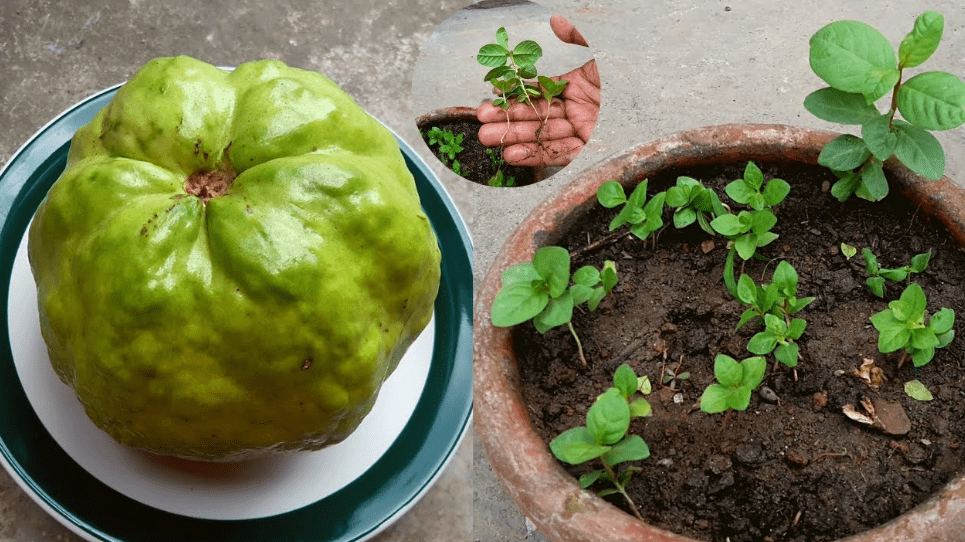
How to Grow Guava from Seed: Transform Your Garden
Guava is a delicious tropical fruit that you can easily grow at home. In this article, we’ll explore how to grow guava from seed with easy-to-follow steps, ensuring you get a thriving guava plant in no time. From selecting the right seeds to nurturing your plants to maturity, you’ll find everything you need to know right here.
Table of Contents
ToggleUnderstanding Guava
A. Botanical Information
Guava, scientifically known as Psidium guajava, is a tropical fruit that belongs to the Myrtaceae family. It is native to Central America and is now grown in many tropical and subtropical regions around the world. Guava trees can reach up to 33 feet in height and have smooth, copper-colored bark. The fruit is round or oval in shape, with a green or yellow skin and sweet, aromatic flesh filled with small, edible seeds. Guava is a rich source of Vitamin C, fiber, and antioxidants, making it a healthy and delicious addition to your garden.
1. Types of guava (common varieties)
There are several common varieties of guava, including the white guava, pink guava, and red guava. Each variety has its own unique flavor and characteristics, so it’s important to consider the specific type of guava you want to grow when selecting your seeds.
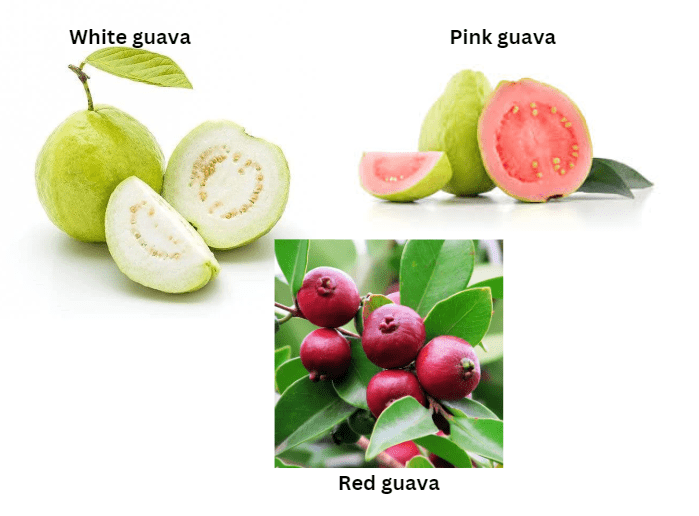
B. Nutritional and Health Benefits
Guava is known for its nutritional and health benefits. It is rich in Vitamin C, which helps boost the immune system and promote healthy skin. Guava is also a good source of fiber, which can aid in digestion and help maintain a healthy weight. Additionally, guava is high in antioxidants, which can help protect the body from damage caused by free radicals. Overall, guava is a healthy and delicious fruit that can be a valuable addition to your diet.
Preparing to Grow Guava from Seed
A. Choosing the Right Seeds
When preparing to grow guava from seed, it is important to choose the right seeds. Look for seeds from a high-quality, ripe guava fruit, as they are more likely to produce healthy and vigorous plants. Additionally, consider the variety of guava you want to grow, as different varieties may have different characteristics and requirements. Selecting the right seeds is the first step in successfully growing guava plants from seed.
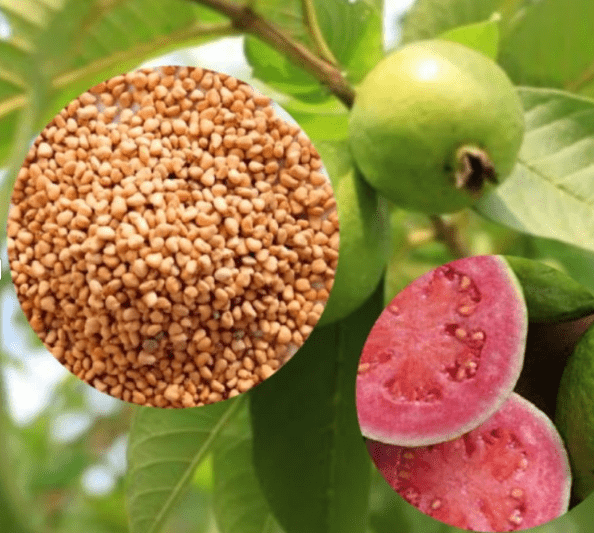
1. Organic vs. non-organic seeds
When choosing guava seeds, it’s important to consider whether you want to use organic or non-organic seeds. Organic seeds are produced without synthetic chemicals or pesticides, which may be appealing to those looking for a more natural and environmentally friendly option. Non-organic seeds may have been treated with chemicals or pesticides, so it’s important to consider your personal preferences and values when selecting the right seeds for your guava plant.
B. Extracting and Preparing Seeds
1. Seed extraction
To grow guava plants from seed, you’ll first need to extract the seeds from a ripe guava fruit. This can be done by cutting open the fruit and removing the seeds from the pulp. It’s important to choose mature and healthy seeds for the best chances of successful germination.
2. Seed preparation
Once you have extracted the guava seeds, it’s important to prepare them for planting. This can be done by washing off any remaining pulp and allowing the seeds to dry completely. This will help prevent mold and rot during the germination process.
C. Soil and Pot Preparation
1. Ideal soil mix for germinating guava seeds
The ideal soil mix for germinating guava seeds is a well-draining, nutrient-rich mix. A combination of potting soil, perlite, and peat moss is commonly used. This will provide a good balance of moisture retention and aeration for the seeds to germinate successfully. It’s also important to choose a pot that is large enough for the seed to grow and has drainage holes to prevent waterlogging.
2. Choosing the right pots or seed trays
When choosing pots or seed trays for germinating guava seeds, it’s important to consider the size and drainage. Opt for pots that are large enough to accommodate the growing seed and have drainage holes to prevent waterlogging. Seed trays with individual cells are also a good option as they provide space for each seed to grow without crowding. Additionally, using biodegradable pots or trays can make transplanting easier, as they can be planted directly into the soil without disturbing the roots.
Germinating Guava Seeds
A. Planting Seeds
Carefully place the guava seeds into the indentations in the soil, and cover them with a thin layer of soil. Gently pat down the soil to ensure good seed-to-soil contact. Water the pots or seed trays lightly, and cover them with a plastic wrap to create a greenhouse effect. This will help retain moisture and create a warm environment for germination.
B. Creating the Ideal Germination Environment
To ensure successful germination of guava seeds, it is important to create the ideal environment for them to thrive. Using biodegradable pots or trays can make transplanting easier, as they can be planted directly into the soil without disturbing the roots. Carefully place the guava seeds into the soil, cover them with a thin layer of soil, and gently pat down to ensure good seed-to-soil contact. Water the pots or seed trays lightly and cover them with plastic wrap to create a greenhouse effect, retaining moisture and creating a warm environment for germination. This will give your guava seeds the best chance of sprouting and developing into healthy plants.
C. Monitoring and Caring for Seedlings
Monitoring and caring for guava seedlings is crucial to their growth and development. It is important to keep the soil consistently moist, but not oversaturated, to ensure the seedlings have enough water to thrive. Place the seedlings in a sunny location, but be sure to protect them from direct sunlight, as it can be too intense for young plants. As the seedlings grow, it is important to provide them with a balanced fertilizer to promote healthy growth. Additionally, be mindful of pests and diseases that may affect the seedlings, and take appropriate measures to protect them. By carefully monitoring and caring for the seedlings, you can help ensure their successful transition into healthy, strong guava plants.
Transplanting Guava Seedlings
A. Preparing for Transplanting
When preparing to transplant guava seedlings, it is important to choose a suitable location with well-drained soil and adequate sunlight. Before transplanting, be sure to water the seedlings thoroughly to help ease the transition. Carefully dig around the seedlings to avoid damaging the roots, and then gently lift them from the soil, being mindful of their delicate root systems. Prepare the new planting hole with a mixture of compost and topsoil to provide the seedlings with the nutrients they need to thrive. Once the seedlings are transplanted, water them well and monitor their progress closely to ensure they adjust to their new environment. With proper care and attention, your guava seedlings should continue to grow and flourish in their new location.
B. Initial Care Post-Transplant
After transplanting your guava seedlings, it is important to provide them with proper care to help them adjust to their new environment. Be sure to water the seedlings regularly, keeping the soil consistently moist but not waterlogged. Mulching around the base of the seedlings can help retain moisture and regulate soil temperature. Additionally, consider using a balanced fertilizer to provide the seedlings with essential nutrients for healthy growth. Monitor the seedlings for any signs of stress or disease, and address any issues promptly. With proper care and attention, your guava seedlings should continue to establish themselves in their new location and thrive.
Caring for Your Guava Plants
A. Watering and Fertilizing
When caring for your guava plants, it is important to ensure they are adequately watered and fertilized. Guava plants require regular watering, especially during the dry season, to keep the soil consistently moist. However, it is crucial to avoid overwatering, as this can lead to root rot. Using a balanced fertilizer can provide the essential nutrients that guava plants need for healthy growth and fruit production. Be sure to follow the recommended dosage on the fertilizer package and apply it evenly around the base of the plant. With proper watering and fertilization, your guava plants will thrive and produce delicious fruits.

B. Pruning and Shaping
When it comes to caring for guava plants, pruning and shaping are important tasks to consider. Pruning helps to maintain the overall health and shape of the plant, as well as encourage fruit production. It is best to prune guava plants during the late winter or early spring before new growth starts. Remove any dead or diseased branches, as well as any overlapping or overcrowded branches to improve air circulation and sunlight exposure. Shaping the plant can help to ensure a strong structure and an aesthetically pleasing appearance. Be sure to use sharp and clean pruning tools to prevent the spread of diseases. With proper pruning and shaping, your guava plants will have a strong foundation for healthy growth and fruit production.
C. Pest and Disease Management
In addition to pruning, it’s important to also consider pest and disease management for guava plants. Common pests that can affect guava plants include scales, mealybugs, and fruit flies. Regularly inspect your plants for any signs of infestation and treat them with appropriate pesticides or natural remedies as needed. Guava plants are also susceptible to fungal diseases such as anthracnose and powdery mildew. To prevent these diseases, avoid overwatering and ensure good air circulation around the plant. Remove any infected leaves or fruit to prevent the spread of disease. By addressing both pruning and pest and disease management, you can help to promote the overall health and productivity of your guava plants.
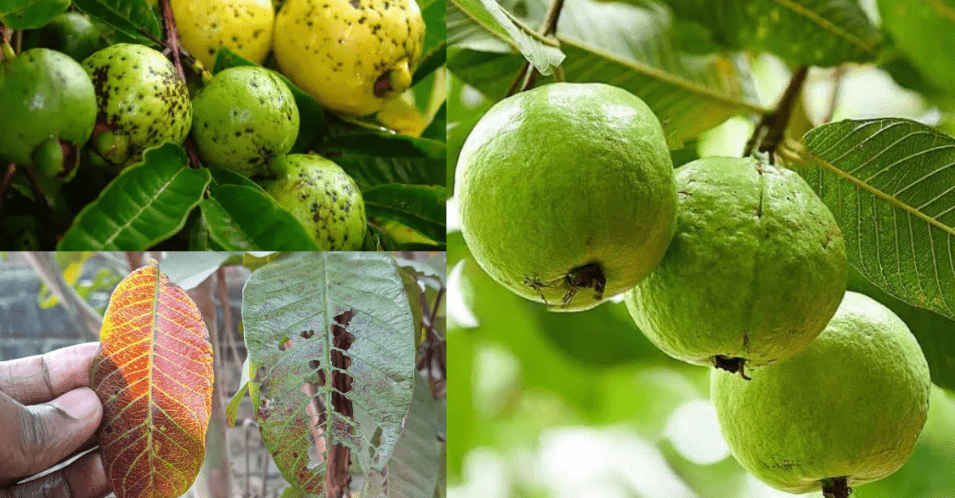
Encouraging Fruit Production
A. Flowering and Pollination
To encourage fruit production in guava plants, it is important to promote healthy flowering and pollination. Guava plants are self-pollinating, but pollination by bees or other insects can help increase fruit set and yield. To attract pollinators, plant flowers or other pollinator-friendly plants near your guava plants. Additionally, ensure that your guava plants receive adequate sunlight, water, and nutrients to support healthy flowering. Pruning can also help promote fruit production by removing dead or damaged branches and allowing for better air circulation and light penetration. By promoting healthy flowering and pollination, you can help increase the fruit production of your guava plants.
B. Maximizing Fruit Yield
To maximize fruit yield in guava plants, it is essential to promote healthy flowering and pollination. Guava plants are self-pollinating, but you can increase fruit set and yield by attracting bees or other insects as pollinators. Planting flowers or other pollinator-friendly plants near your guava plants can help attract these beneficial insects. It is also important to ensure that your guava plants receive adequate sunlight, water, and nutrients to support healthy flowering. Pruning is another important aspect of promoting fruit production, as it helps remove dead or damaged branches and allows for better air circulation and light penetration. By taking these steps to encourage healthy flowering and pollination, you can maximize the fruit yield of your guava plants.
C. Harvesting Guavas
To harvest guavas, it is important to wait until the fruit is fully ripe and has developed its characteristic aroma. Guavas are typically ready to pick when they have a yellowish-green skin and a slight give when gently pressed. To harvest, simply twist the fruit gently until it separates from the branch. It is important to handle the fruit carefully to avoid bruising and damage. Once harvested, guavas should be stored at room temperature and consumed within a few days for the best flavor and texture. By following these guidelines, you can ensure a successful guava harvest.
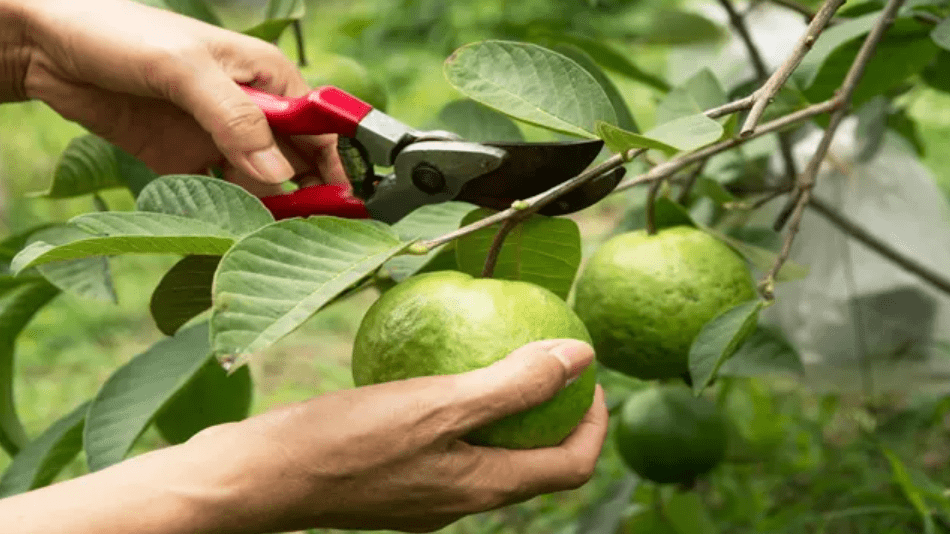
Integrating Guava into Your Garden Landscape
A. Designing with Guava Plants
When integrating guava plants into your garden landscape, it is important to consider the space and climate in which they will be planted. Guava plants thrive in warm, tropical climates and require well-drained soil and full sunlight for optimal growth. When designing with guava plants, it is important to provide ample space for the plants to spread out, as they can grow quite large. Additionally, consider their height and spread when choosing their location in the garden to ensure they have enough room to grow. Guava plants can also be used as a natural hedge or privacy screen, providing both beauty and functionality in your garden landscape. By carefully considering their placement and surroundings, you can create a beautiful and thriving garden with guava plants.
B. Container Gardening with Guava
When considering container gardening with guava plants, it is important to choose a large enough container to accommodate the plant’s growth. The container should have good drainage to prevent waterlogging and should be filled with well-draining soil. Guava plants also require full sunlight, so it is important to place the container in a sunny location. Regular watering and fertilizing are essential for the plant’s health and growth, so be sure to monitor and maintain the plant’s care. Container gardening with guava plants can be a great option for those in cooler climates or limited space, as they can be moved indoors during colder weather. With proper care and attention, you can enjoy the benefits of guava plants in a container garden.
C. Sustainable Gardening Practices
Sustainable gardening practices are important for reducing environmental impact and promoting the health of your garden and surrounding ecosystem. This can include using organic and natural fertilizers and pesticides, conserving water through efficient irrigation methods, and promoting biodiversity by planting native species and providing habitats for beneficial insects and wildlife. Composting and recycling materials in the garden can also contribute to sustainability by reducing waste and improving soil health. By implementing sustainable gardening practices, you can create a more resilient and ecologically-friendly garden for future generations.
In conclusion, growing guava from seed can be a rewarding and enjoyable experience for any gardener. By following the steps outlined in this article, you can transform your garden and enjoy the delicious fruits of your labor. From planting to harvesting, the process of growing guava can be a fulfilling and satisfying journey. Whether you have a green thumb or are just starting out, growing guava from seed is a great way to enhance your garden and enjoy the fruits of your labor.
Frequently Asked Questions (FAQs)
To start growing guava from seed, first, you need to remove the seeds from a ripe guava fruit. Then, wash the seeds to remove any pulp and let them dry for a few days. Once dry, plant the seeds in a pot with well-draining soil and keep the soil consistently moist.
Guava seeds can take anywhere from 2 to 8 weeks to germinate, so be patient and make sure to keep the soil moist during this time.
Guava plants thrive in warm, tropical or subtropical climates with plenty of sunlight. They also need well-draining soil and regular watering.
Guava plants can grow to be anywhere from 10 to 30 feet tall, so make sure to give them plenty of space to grow.
It can take anywhere from 2 to 8 years for a guava tree to start bearing fruit, so be prepared for some patience before you can enjoy your own homegrown guavas.
Guava plants don’t require a lot of maintenance, but it’s important to regularly fertilize them with a balanced fertilizer and prune them to maintain their shape and encourage fruit production.
Guava plants are sensitive to cold temperatures and can be damaged by frost. If you live in a colder climate, consider growing guava in a greenhouse or as a container plant that you can bring indoors during the winter.
Yes, you can start growing guava from seeds indoors in a pot with well-draining soil and plenty of sunlight. Just make sure to transplant the seedling to a larger pot or your garden once it outgrows its initial container.
